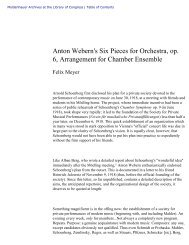Country Profile: Cuba - American Memory - Library of Congress
Country Profile: Cuba - American Memory - Library of Congress
Country Profile: Cuba - American Memory - Library of Congress
You also want an ePaper? Increase the reach of your titles
YUMPU automatically turns print PDFs into web optimized ePapers that Google loves.
<strong>Library</strong> <strong>of</strong> <strong>Congress</strong> – Federal Research Division <strong>Country</strong> <strong>Pr<strong>of</strong>ile</strong>: <strong>Cuba</strong>, September 2006<br />
Land Boundaries: <strong>Cuba</strong> has a total land boundary <strong>of</strong> 29 kilometers bordering the U.S. naval<br />
base at Guantánamo Bay.<br />
Disputed Territory: The United States has leased the Guantánamo Bay naval base area from<br />
<strong>Cuba</strong> since 1903, but the Castro regime has never recognized the legitimacy <strong>of</strong> the leasing<br />
arrangement. Although the 1901 Platt Amendment was repealed in 1934, the 1903 lease<br />
agreement has continued as a result <strong>of</strong> the Treaty <strong>of</strong> Relations signed by the United States and<br />
<strong>Cuba</strong> in 1934.<br />
Length <strong>of</strong> Coastline: <strong>Cuba</strong>, with more than 4,000 coves and inlets, has an irregular coastline<br />
that is 3,209 kilometers on its northern side and 2,537 kilometers on its southern side, for a total<br />
<strong>of</strong> 5,746 kilometers. The coastline <strong>of</strong> Isla de La Juventud is 327 kilometers long.<br />
Maritime Claims: As a signatory to the Law <strong>of</strong> the Sea Treaty, <strong>Cuba</strong> claims a 12-nautical-mile<br />
territorial sea and a 200-nautical-mile exclusive economic zone.<br />
Topography: <strong>Cuba</strong> is a long but relatively narrow island. About two-thirds <strong>of</strong> its land surface is<br />
covered with fertile plains suitable for cultivation; three principal, heavily forested mountain<br />
ranges cover the rest <strong>of</strong> the country. The Sierra de los Órganos, which rises to a maximum<br />
elevation <strong>of</strong> about 686 meters, lies to the west <strong>of</strong> Havana. Toward the center <strong>of</strong> the island is the<br />
Sierra de Trinidad, which reaches a maximum elevation <strong>of</strong> 1,006 meters and together with the<br />
Sierra de Sancti Spíritus constitutes the Sierra de Escambray. Still farther east lies the island’s<br />
highest and most rugged mountain range, the Sierra Maestra, which encircles the city <strong>of</strong> Santiago<br />
de <strong>Cuba</strong> and includes <strong>Cuba</strong>’s highest peak, the Pico Real del Turquino (1,974 meters). Large<br />
tracts <strong>of</strong> mangrove swamp are particularly prevalent in the south and southwest, whereas the<br />
northern coastline is steep and rocky.<br />
Principal Rivers: <strong>Cuba</strong> has 30 south-flowing and 11 north-flowing rivers with a total length <strong>of</strong><br />
3,932 kilometers. The average length <strong>of</strong> <strong>Cuba</strong>’s major rivers, none <strong>of</strong> which are navigable to any<br />
significant extent, is 93 kilometers. The island’s longest river is the 370-kilometer Cauto, which<br />
flows from the eastern mountains to the southern coast and is navigable for about 80 kilometers.<br />
<strong>Cuba</strong>’s most important hydrographic basins are the Cauto, Zaza, and Sagua la Grande.<br />
Climate: <strong>Cuba</strong>’s climate is subtropical, warm, and humid; annual mean temperatures average<br />
25º C. The hottest month in Havana (24 meters above sea level) is August, with an average<br />
monthly minimum <strong>of</strong> 24º C to 32° C; the coldest months are January and February, averaging<br />
18º C to 27° C (with occasional freezing temperatures in mountainous areas). <strong>Cuba</strong>’s average<br />
annual rainfall is 1,400 millimeters, but the annual amount varies greatly from year to year. The<br />
driest months are February and March, averaging 46 millimeters <strong>of</strong> rainfall. The wettest month is<br />
October, with average rainfall <strong>of</strong> 173 millimeters. Most <strong>of</strong> <strong>Cuba</strong> experiences a rainy season from<br />
May to October. The country averages about one hurricane every other year. The most frequent<br />
storms occur in September and October, but hurricane season generally runs from June to<br />
November (from August to November on the east coast). Heavy rains may cause landslides in<br />
hills and mountain slopes in the highlands.<br />
6



![Albert Einstein Papers [finding aid]. Library of Congress. [PDF ...](https://img.yumpu.com/21604228/1/190x245/albert-einstein-papers-finding-aid-library-of-congress-pdf-.jpg?quality=85)





![American Colony in Jerusalem Collection [finding aid]. Library of ...](https://img.yumpu.com/17941275/1/190x245/american-colony-in-jerusalem-collection-finding-aid-library-of-.jpg?quality=85)



![Piccard Family Papers [finding aid]. - American Memory - Library of ...](https://img.yumpu.com/17941234/1/190x245/piccard-family-papers-finding-aid-american-memory-library-of-.jpg?quality=85)


